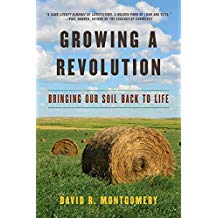Growing a Revolution was inspiring Thanksgiving holiday reading. Written by MacArthur Fellowship recipient David Montgomery of the University of Washington, the book reports on global examples of farmers adopting practices of “conservation agriculture” which restore soil as a renewable resource, instead of degrading soil over time.

By avoiding plowing, using cover crops, and employing crop rotation, farmers are able to use much lower levels of fertilizers, pesticides and fuel and make higher profits, with less vulnerability to drought and storms. These practices result in less polluting runoff, better habitat for biodiversity, and – not least – store increasing amounts of carbon in the soil.
The book explains how relatively recent scientific progress in soil ecology and microbiology has provided greater understanding of the systems that build up productive soil – plants have symbiotic relationships whereby they feed sugars to fungi that deliver nutrients to plants and emit proteins that hold soil together; the fungi have symbiotic relationships with bacteria that metabolize nitrogen, phosphorus, and other minerals. Earthworms, termites, ants, other invertebrates and their micro-symbionts help digest compost, recycle nutrients and structure soils to retain water.
This mutualistic ecosystem is much more complex than simplistic equations that calculate the amount of fertilizer and water inputs needed to grow plants for harvest. Input-based agriculture can deliver high crop yields in the short term, but degrades the soil leading to lower productivity over time.
The practice of plowing breaks the connections between plants and the fungi that feed them; plants well-fed with synthetic fertilizers don’t provide nutrition to symbionts; and pesticides also kill the beneficial organisms that enable soils to hold moisture. So dry soils and extra fertilizers are washed away by irrigation and rainstorms. Fields that are plowed and treated with fertilizers and pesticides gradually lose soil, require even more fertilizer, are more vulnerable to drought and storms, and shed carbon into the atmosphere.
Healthy soil practices are extremely promising for climate protection. Scientific estimates differ, but it is clear that the broad use of agricultural practices that restore soil carbon instead of mining it could go a long way toward pulling carbon out of the atmosphere. And the book shows how farmers adopting healthy soil practices can start regenerating soil and improving farm economics within a few years – potentially leading to relatively rapid carbon drawdown.
The focus of “conservation agriculture” on building up soil health is different from the focus of “organic agriculture” on refraining from all synthetic fertilizers and pesticides. Farms can practice conservation agriculture, use much lower levels of pesticides and fertilizers, and increase soil carbon, but still not qualify as organic. By contrast, a farm could be certified “organic”, but use frequent plowing that breaks up soil ecosystem, and use monoculture practices that depend on “organic fertilizers”, while still eroding soil and losing carbon over time.
But “healthy soil” practices aren’t yet visible to consumers. While “organic” has become a mainstream brand allowing consumers to choose foods produced without synthetic pesticides and fertilizers, there isn’t yet a certification system and brand allowing consumers to choose food that was grown with practices that maintain soil and climate health. The book identifies this as a potential opportunity to engage consumer power in promoting healthy soil practices.
The book identifies other institutional barriers hampering broad-scale adoption of conservation agriculture. In the US and many places around the world, agricultural education and farm support programs are largely geared toward promoting high-input monoculture. The major corporate purveyors of fertilizers and pesticides have lobbied for policies and incentives to keep the system of input-dependent monoculture well-entrenched. “Crop insurance” programs help insure farmers against drought and storms, but don’t support “preventive care” investments to help farmers get started with practices that make farms more resilient to drought and storms.
Most of the US-based farmers in the book were in red states, and had conservative, conservationist beliefs as well as economic self-interest motivating their soil health practices. Hopefully there is some combination of rural local politics and “green new deal” climate advocacy that can break the logjam and accelerate the spread of healthy soil practices.
The potential is great. “Growing a Revolution” makes a strong case that practices to reverse long-term soil damage are relatively simple, cost-effective, and transformative for farmers, ecosystems, and climate. With climate change evident in the fires burning California, the stakes couldn’t be higher.